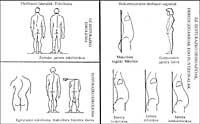Deviations from the column
Scoliosis Scoliosis
It is the deviation or deformation of the column in the lateral plane.
It is more frequent in children than in adults, especially in the growth phase. 1 in 20 average children is affected by scoliosis and more in girls than in boys
However, we must differentiate:
a) SCOLIOTIC POSTURE Wrong column but with a small muscle effort recovers its normal state, corrects.
It may be by adopting asymmetric postures (feel bad, etc. ). ). Either they can be called ZAMAK SCOLIOTIC ATTITUDES (or ZAMAKO), when a lower extremity is shorter than the other, so the body "falls" to that side.
However, they should not be discarded or despised, since if there is a muscle weakness and this inadequate posture is not corrected, eventually a true scoliosis may appear.
Treatment: Treatment: Enhance the muscles of the spine, rehabilitation (through exercises and proper postures).
b) Scoliosis
In this case the back is not symmetrical, that is, the left and the right are different. On the other hand, it is not possible by itself (without force or external mechanical means) that the column recovers its correct position.
- Why does scoliosis arise? In 25% they are known causes: myopathies, infectious diseases (typhus, tuberculosis, etc. ). ), cancer. Also traumatic scoliosis, congenital, hysterical, etc. Also. In 75%, however, we do not know very well what their reason is. That is why we call them IDIOPATHIC. Scoliosis begins with 6-7 years, which are the most dangerous, or before adolescence.
- How can you see or diagnose it? Normally in ikastola, when the child does physical exercise or sport, the teacher realizes that he has a shoulder orphan higher than the other, that the lumbar folds are different on each side, etc. To be sure you have to make x-rays: the most useful are those that have gone before and not those that have gone out. A small test should be done to children:
– Standing, with hands on the sides of the body and the child calm (relaxed), look at the column. – If we had doubts we will tell the child to bend forward without bending the legs (straight knees). If there was scoliosis, the deviation would be highlighted.
- What importance does scoliosis have? It can cause PAIN. Children, however, almost never complain. LUNG CAPACITY can be reduced in severe cases. The most serious complication is COMPRESSION (corresponding to the marrow of the vertebrae of the column). Fortunately, it occurs in very few cases.
- Treatment of treatment Treatment
a) In moderate or medium cases: Tractions can be needed along with plaster seals. The gymnastics is highly recommended. Sports, when they are symmetrical, that is, when the two parts of the body work symmetrically or similarly (basketball, handball, swimming above all) are convenient. Also classical dance or ballet. Others are not suitable (tennis).
b) In serious cases the only remedy will be SURGERY. If the deviation exceeds 35-40, it takes advantage of the surgery to correct the column, but the scoliotic bending is never fully corrected, since technically it is not possible on the one hand, and from a limit (when the average deviation is superior to 50 or) with the correction we would run the risk of wounding the ornomuine.
- Prevention of prevention and prevention
a) In children: When you go to ikastola, we divide the weight into both hands, or better still take it to the back (backpack covers). Visual problems can also have their importance. Avoid vital or harmful attitudes (when writing or sitting). b) In adults: Do not use too soft mattresses in bed, or thick of the head. Be careful when you get up out of bed! The muscles must be heated. So, to a certain extent, “get used to it” do not make excessive efforts. It is recommended to adopt suitable positions in the car (chair, air gusts in the windows, etc. ). During work, performing some exercises from time to time can help.
Lordosis, kyphosis
In the antero-back plane, the column is mainly composed of two bending.
- Kyphosis of the dorsal vertebrae (D 1 -D 10 ): convexity 15-20.
- Lumbar lordosis. The articulation of the kingdom with the last lumbar vertebra turns backwards, with an average of 30o (concave).
Alterations can be made by three ways:
- Existing normal inclinations exaggerating: Dorsal hypercifosis, lumbar hyperlordosis.
- Correction (or correction) is insufficient: dorsal plane (i.e., dorsal kyphosis less than necessary), or straight spine (decrease of the lumbar lordosis).
- There is still another way: in unusual places, the appearance of this type of torsions.
Here, as with scoliosis, we must differentiate attitudes (lordotic, cyphotic), easily correctable and actual kyphosis or lordosis.
When can these cases appear?
- As a child, because the binders are very calm (hyper-laxity).
- Because inadequate postures are used.
- Tailor, mechanographs, students: kyphosis.
- Pregnant woman by softening the abdominal premusculature: lordosis.
- Associated with some disease system:
- Rickets or poliomyelitis cause kyphosis, along with many other deformations.
- Tuberculosis (Pott disease) can also produce kyphosis.
- Rheumatism.
- Arthrosis.
- Osteoporosis in the elderly, etc.
Treatment of treatment Treatment
- POSTCARD. Avoid inadequate postures.
- PHYSIOTHERAPY: special gymnastics, muscle rehabilitation,…
- MECHANICAL MEDIA: Corses varied.
- OSTEOTOMY may also be necessary: surgical cutting and extraction of one or more vertebrae.






